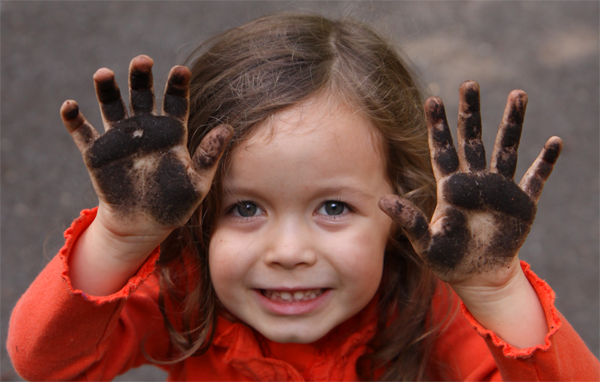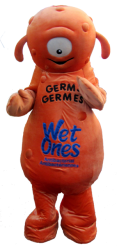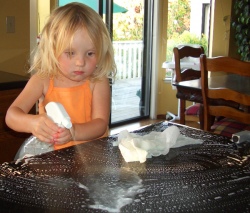
Can Homes be too Clean for Health?
Yes, a growing body of evidence suggests hyper-clean homes aren’t always healthy. Not only are today’s homes dirt free, energy codes encourage tight building, effectively sealing the environment like Tupperware. Together these trends reveal Westerners live in sterile bubbles. Yet the research is clear, this lifestyle choice is causing a public health crisis.

How Does Clean Cause Disease?
In mortal fear of germs, parents treat homes like hospitals. All contaminants are considered evil. From birth, today’s kids are isolated from diverse healthy bacteria, mild pathogens and allergens. But that’s exactly what the immune system needs to mature and become robust, according to the largely accepted hygiene hypothesis.
When finally venturing outside (if only to the car), these bubble kids can’t cope. Their immune systems are ill prepared for the messy realities of a dirty world. Sadly, stunted immune systems lead to chronic inflammatory diseases including allergies, asthma and eczema. Once rare, these maladies have rapidly increased in young populations. Studies also suggest reduced microbial exposure may affect gut bacteria (the mocrobiome) leading to autoimmune diseases like type 1 diabetes, celiac disease and lupus. However, this link isn’t confirmed. Even more controversial, some researchers believe overly clean homes cause depression, autism and cancer.
A recent mainstream study found that gut bacteria affects Parkinson’s disease. While bacteria may contribute to some diseases like Parkinson’s, there’s currently no way for the masses to verify which bacteria is present and how it can be altered. Expect the microbiome to provide exciting new directions for medicine. Perhaps domestic environments will soon be used in therapies.
Hygiene and Clean Aren’t The Same
Parents confuse healthy living with cleanliness. They aren’t alone, the entire health community confuses hygiene with clean. In clinics and hospitals, all germs can be dangerous and must be avoided. A productive approach, allowing great advancements in surgical techniques and treatments.
Tracking mud into a hospital is unthinkable. In wounds, dirt causes serious infections. However, mud may be good for home life. While bad germs must be avoided. A lack of contact with nature, especially good clean dirt, seems key to a healthy childhood. The big question; where’s the fine line between clean and too-clean?
Scientists feverishly hunting for answers, think they’ve found a clue. People living in primitive societies have substantially more diverse gut bacteria. They’ve been exposed to vastly more microbial variety than modern, urban cultures. Primitives also have less incidence of allergies and other “Western” maladies. The fine line appears to be a lifestyle which promotes diverse exposure to natural microbes and allergens starting at birth. While recommendations will likely change, following is an action plan based on current research:

Avoid an Antibiotic Home Modern home life is full of antibiotics and antimicrobial products. A key to healthy homes is reducing their use. These products don’t discriminate between good and bad bacteria. Consider them the nuclear option. Even appropriate use of antibiotics reduces diversity in gut bacteria for kids. While, antimicrobial soaps kill good bacteria that help immune systems mature.
• Don’t be eager to sanitize. Simply wipe kitchen counters with soap and water, unless that package of raw chicken leaked all over.
• Save sanitizing for toilets and areas likely harboring unwanted microbes. Definitely sanitize surfaces touched by a sick family member.
• Hand wash dishes occasionally, instead of only using the dishwasher. Studies show this lower level of sanitation helps prevent eczema in children.
• Don’t rely on antibiotics for every sniffle. Many illnesses are viral and unaffected with drugs. Don’t automatically reach for the antibiotic ointment with every scratch either. Simple soap and water cleans small wounds effectively. The overuse of antibiotics has been linked to antibiotic resistance in bad germs.
Avoid a Prebiotic Home
Recently the term, “Prebiotic” has become popular. Prebiotics are foods promoting the growth of beneficial bacteria. When it comes to homes however, promoting the good without including the bad is impossible. Better to minimize all biotic growth. Since many building products provide a microbial food source. Reducing moisture becomes the main battle. See buildewise.org’s definitive mold post for further information about moisture reducing home design practices. Which includes:
• Fix leaks inside and out. Don’t allow accumulated or standing water anywhere, from any source (except in toilets and p-traps).
• Ensure good ventilation and natural sunlight.
• Don’t over heat or cool your home. Extreme differential temperatures promote condensation on window and wall surfaces. In winter, wear a sweater. Strip down in summer.
• Monitor humidity levels. Reduce room humidity when it rises above 50%.
• Don’t install absorbent finishes, including layers like wall paper or wood paneling in kitchens, baths and basements where microbes can hide. Forget about carpet or wood flooring in kitchens, baths and entries (or indoor/outdoor) areas.
• Minimize clutter. Yes, that means clean your bedroom.
Promote a Probiotic Home
“Probiotic” is also a vogue food term for items containing actual live bacteria. In the same spirit, some suggest we spray microbes on home surfaces. Much like seeding yogurt with good bacteria. However, the science isn’t there yet (with homes or yogurt). One is likely to create unpredictable consequences or nothing at all. The more practical goal is providing neutral floor surfaces that accept microbes without extermination or rapid growth.
Why focus on floors? Tests show that a home’s floors harbor most of the bacteria tracked in from outside. So flaunt it. Choose durable, water resistant products. Keep these floors wiped, but not sanitized.
• Install ceramic or stone tile instead of carpet or even wood flooring. Also consider a trim base and shoe minimizing that ugly gap between floor and wall. A place that’s hard to clean and harbors – well who knows what.
• Promote outdoor living, especially patios at ground level directly off the kitchen, family or great room. Install huge French doors and open your home to the great outdoors. Live in an apartment? Stock up on potted plants or spend quality time at the park.
• Get a dog. Dogs track dirt, they can’t help it. Studies show that kids growing up with dogs (but not cats) have less allergies. Sorry cat owners.
• Relax, let kids and dogs get dirty. Go out and garden, get dirty yourself. Track in the mud, it’s OK. Chances are you’re creating a probiotic environment that’s good for everyone.
Further Reading:
Finlay, B. Brett & Arrieta, Marie-Claire.
Let Them Eat Dirt: Saving Your Child from an Oversanitized World.
Chapel Hill NC: Agonquin Books, 2016. Hard Cover
304 pages, 6″x 9″ size, all text. A great book by two microbiologists, explaining the latest science about this subject. Geared towards expecting parents or families with young children.
WebMD
Too-Clean Homes May Encourage Child Allergies
A good web article explaining the current science about cleanliness versus hygiene.
The Journal of Allergy and Clinical Immunology
Amish children living in Northern Indiana have a very low prevalence of allergic sensitization
A seminal research study that supports the hygiene hypothesis.
Photo Credits:
Dirty Hands adapted from Larry Ewing
Boogy Monster adapted from Loosr Boy
Oversanitized adapted from Ruan Harvey
It is rare for me to uncover something on the web thats as entertaining and intriguing as what you have got here. Your page is sweet, your graphics are great, and whats much more, you use source that are relevant to what youre saying. That you are undoubtedly one in a million, well done! dadcbaeecdkedfdk
Its really a great and useful piece of information. Im glad that you shared this useful info with us. Please keep us informed like this. Thanks for sharing. dgkfebdbadcdfaae
Fckin awesome things here. I am very glad to see your article. Thanks a lot and i’m looking forward to contact you. Will you please drop me a mail? dkedbeekdekgfkde
Wow! This could be one particular of the most useful blogs We’ve ever arrive across on this subject. Actually Excellent. I’m also an expert in this topic so I can understand your hard work. fedeekgdafffgkbe
Only wanna tell that this is very useful , Thanks for taking your time to write this. fedbeaegdaaafecf